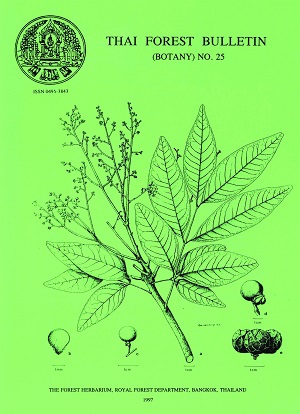Geographical and Ecological Distributions of the two Tropical Pines, Pinus kesiya and Pinus merkusii, in Southeast Asia
Keywords:
Tropical Pines, Pinus kesiya, Pinus merkusii, Southeast AsiaAbstract
Geographical and ecological distributions of the two tropical pines, Pinus kesiya and P. merkusii in Southeast Asia are clarified and illustrated. The taxonomic confusions of the species complex, P. kesiya and P. yunnanensis are briefly discussed. Pinus kesiya illustrates a northerly distribution pattern whereas P. merkusii can be encountered as far south as in central Sumatra, the only place where the genus Pinus occurs naturally south of the Equator. In Thailand P. kesiya is mainly associated with lower montane pine-oak forest whilst P. merkusii is a characteristic species of pine-deciduous dipterocarp forest and pine-oak savanna. Occasionally, P. kesiya is locally found co-dominant with P. merkusii in the moister areas of pine-deciduous dipt~rocarp forest. The optimal altitudinal range of P. kesiya is recorded at above 1,000 m.a.s.l. In northern Thailand the pine-oak association is reduced considerably above 1,500 m.a.s.l., and pine trees (P. kesiya) here are rather sporadic in occurrence. However, in the higher mountain ranges north of the Thai territory (i.e. Assam, Yunnan), P. kesiya (including P. yunnanensis) proliferates at the altitudinal zone from 1,500 to 2,900 m.a.s.l. Pinus merkusii usually reaches its best development at below I ,000 m.a.s.l. in the pine-deciduous dipterocarp forest or the savanna-iike pine-deciduous dipterocarp vegetation. The lowest altitudinal distributions of the tropical pines are represented by P. merkusii in Thailand (at ca 70 m.a.s.l.) and the Philippines (at ca 60 m.a.s.l.).Downloads
Download data is not yet available.
Downloads
How to Cite
Santisuk, T. (2014). Geographical and Ecological Distributions of the two Tropical Pines, Pinus kesiya and Pinus merkusii, in Southeast Asia. Thai Forest Bulletin (Botany), (25), 102–123. retrieved from https://li01.tci-thaijo.org/index.php/ThaiForestBulletin/article/view/25016
Issue
Section
Articles



